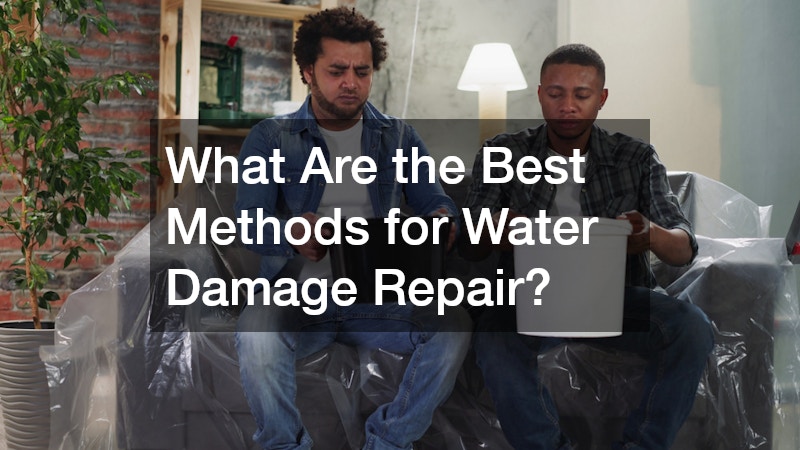
Water damage poses a significant threat to homes and businesses, often resulting from floods, leaks, or other unexpected disasters. Once water infiltrates a structure, it can lead to severe consequences, including structural damage, mold growth, and loss of valuable possessions. Understanding the best methods for water damage repair is crucial in mitigating these effects and protecting properties. Proper water damage repair requires a systematic approach that addresses the extent of the damage and the source of water intrusion.
Video Source
In this article, we will explore effective methods for repairing water damage to ensure your space is restored safely and efficiently.
The first step in water damage repair is to assess the extent of the damage. This involves examining the affected areas for signs of water intrusion, such as discoloration, warping, or mold. It’s essential to document the damage thoroughly to determine the best course of action. Professionals often use specialized equipment like moisture meters and thermal imaging cameras during this phase. These tools help pinpoint hidden moisture, allowing for a more accurate assessment of what needs to be addressed.
Once an initial assessment is complete, it’s important to identify the source of the water intrusion. It could stem from various sources, such as burst pipes, overflowing toilets, or natural flooding. Understanding the root cause of the problem is imperative, as it allows you to implement necessary repairs to prevent further incidents. Ignoring this step could lead to recurring issues and increased repair costs, underscoring the significance of addressing the underlying source. By conducting a comprehensive assessment, you lay the groundwork for effective water damage repair.
After assessing the damage, the next critical step in water damage repair is removing damaged materials. This includes drywall, insulation, flooring, or any personal belongings that cannot be salvaged. Removing these items reduces the risk of mold growth and further structural damage, making it a vital part of the process. In some cases, if materials are just damp, drying them out within a few days can save them, but if they show signs of mold or rotting, disposal is necessary. Proper disposal must follow local regulations, especially when dealing with hazardous materials.
In addition to physical removal, thorough cleaning is essential to prevent mold and bacterial growth. This may involve scrubbing surfaces with bleach solutions or other disinfectants to eliminate any potential contaminants. Failing to clean adequately can have serious long-term consequences for health and safety in affected areas. Use of PPE (personal protective equipment) is recommended while handling contaminated materials to ensure safety. This part of the water damage repair process may be labor-intensive, but it is crucial for effective recovery.
After removing damaged materials and cleaning the affected areas, the next critical step in water damage repair is drying and dehumidifying. It is essential to eliminate any remaining moisture to prevent mold growth, which can start within 24 to 48 hours after water exposure. Using industrial fans, dehumidifiers, and heaters can expedite this process significantly. These tools not only dry out the affected areas but also help maintain a controlled environment to avoid further damage. The drying process can take several days to weeks, depending on the severity of the water intrusion.
Monitoring the drying process is equally important to ensure efficiency. Regularly checking moisture levels with a moisture meter will help determine when surfaces are adequately dry. Water damage repair is not complete until moisture levels have returned to normal levels, as residual moisture can lead to future problems. Being patient during this step is critical, as rushing it could result in costly mold remediation in the future. Waiting until everything is thoroughly dry before moving on to repairs makes a significant difference in the overall results.
The final stage in water damage repair involves restoration and repair of the affected areas. This means replacing any damaged materials, such as drywall, flooring, and insulation, with new and potentially upgraded options. During this phase, it’s essential to ensure that all electrical and plumbing systems are functioning correctly before enclosing walls or floors. Engaging the help of professionals can ensure that restoration adheres to local building codes and standards. Proper installation not only restores aesthetics but also guarantees safety and functionality.
It's also an excellent time to consider preventive measures against future flooding or leaks. This could include sealing windows, installing sump pumps, or improving drainage around the property. Making these changes can significantly reduce the risk of future water damage and provide peace of mind for homeowners. Preventive measures are an essential part of long-term water damage repair strategies, contributing to the overall integrity of the property. Restoration is not just about repairing what was damaged but also about enhancing resilience against future issues.
Finally, after the restoration is complete, a thorough inspection of the repairs should be conducted. This ensures that everything is up to standard and properly sealed, preventing potential issues down the line. Often, minor adjustments might be necessary, and addressing them now could save a lot of trouble in the future. Keeping records of the repair process can also be valuable for insurance purposes. Ultimately, successful water damage repair restores not just the physical space, but also the comfort and safety of your home or business.
